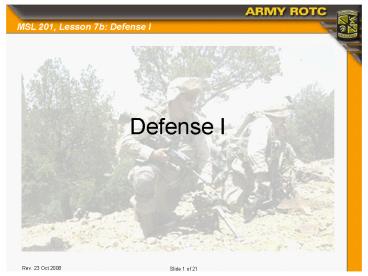MSL 201, lesson 7b - PowerPoint PPT Presentation
1 / 21
Title:
MSL 201, lesson 7b
Description:
Preoccupy the enemy in one area. Erode enemy forces. Disrupt or ... Deny an area to an attacking enemy ... Emplace antitank and Claymore mines, then wire and ... – PowerPoint PPT presentation
Number of Views:315
Avg rating:3.0/5.0
Title: MSL 201, lesson 7b
1
Defense I
2
Purpose of the Defense
The general task and purpose of all defensive
operations is to defeat an enemy attack and gain
the initiative for offensive operations. A
platoon may conduct the defense for some of the
following reasons
- Gain Time
- Retain key terrain
- Facilitate other operations
- Preoccupy the enemy in one area
- Erode enemy forces
- Disrupt or Disorganize
- Delay
- Defeat an attacking enemy
- Deny an area to an attacking enemy
- Protect a flank
3
Characteristics of the Defense
- Preparation
- Security
- Disruption
- Massing effects
- Flexibility
4
Sequence of the Defense
- Occupation
- Approach of the enemy main attack
- Enemy assault
- Counterattack
- Consolidation and reorganization
5
Defensive Positions - Priority of Work
- Stage 1
- Emplace local security (all leaders).
- Position and assign sectors of fire for each
squad (platoon leader). - Position and assign sectors of fire for the CCMS
and medium machine gun teams (platoon leader). - Position and assign sectors of fire for M249 MG,
grenadiers, and riflemen (squad leaders). - Establish command post and wire communications.
- Designate FPLs and FPFs.
- Clear fields of fire and prepare range cards.
- Prepare sector sketches (leaders)
- Dig fighting positions
FM 3-21.8, paragraph 8-91, pages 8-20 to 8-21.
6
Defensive Positions - Priority of Work
- Stage 2
- Establish communication and coordination with the
company and adjacent units - Review sector sketches
- Emplace antitank and Claymore mines, then wire
and other obstacles - Mark or improve marking for TRPs and other fire
control measures - Improve primary fighting positions and add
overhead cover - Stage 3
- Prepare supplementary and then alternate
positions (same procedure as the primary
position) - Establish sleep and rest plans
- Distribute and stockpile ammunition, food, and
water - Dig trenches to connect positions
- Continue to improve positionsconstruct
revetments, replace camouflage, and add to
overhead cover
Unit priorities of work are normally found in
SOPs. However, the commander will dictate the
priorities of work for the company based on the
factors of METT-TC. Several actions may be
accomplished at the same time. Leaders must
constantly supervise the preparation of fighting
positions, both for tactical usefulness and
proper construction.
7
Defense Techniques Reverse Slope
8
Defense Techniques Reverse Slope
The platoon leaders analysis of the factors of
METT-TC often leads him to employ his forces on
the reverse slope (Figure 8-15). If the rifle
squads are on a mounted avenue of approach, they
must be concealed from enemy direct fire
systems. This means rifle squads should be
protected from enemy tanks and observed
artillery fire.
9
Defense Techniques Perimeter Defense
10
Defense Techniques Perimeter Defense
Figure 8-14. Perimeter defense with rifle team in
reserve. NOTE A variant of the perimeter
defense is the use of the shaped defense, which
allows two of the platoons squads to orient at
any particular time on any of three engagement
areas.
11
Defense Techniques Defense in Sector
12
Defense Techniques Mutually Supporting Battle
Positions
13
Types of Fighting Positions
- Number of Personnel
- Types of Weapons
- Time available
- Terrain
14
Hasty Fighting Position
15
One-Soldier Fighting Position
16
Two-Soldier Fighting Position
17
Stages of Fighting Position Preparation
Stage 1
18
Stages of Fighting Position Preparation
FRONT WALL Two sandbags high by two M16s
HELMET
Stage 2
FLANK WALL Two sandbags high by One M16 long
FLANK WALL Two sandbags high by One M16 long
REAR WALL One sandbags high by one M16s
- The front wall is two to three sandbags (or
logs) high. - For a two-soldiers position, it is about two
M16 long. - The flank walls are the same height, but only
one M16 Long. - The rear wall is one sandbag high by one M16
long. - If logs are used, they must be held firmly in
place with - strong stakes about 2 inches to 3 inches in
diameter - and 18 inches long.
- The leader inspect the position.
19
Stages of Fighting Position Preparation
FRONTAL COVER
GRENADE SUMPS
FLANK COVER
FLANK COVER
Stage 3
STORAGE AREA
HOLE IS ARMPIT DEEP
REAR COVER
- The position is dug armpit deep.
- The parapets are filled in order
- of front, flanks, and rear
- The parapets and the entire
- position are camouflaged.
- Grenade sumps are dug and the
- floor sloped toward them
- Storage areas for the two rucksacks
- May also be dug into the rear wall
- The leader inspects the position
20
Stages of Fighting Position Preparation
Stage 4
LOGS (overhead cover)
- Five to six log 4 to 6 inches in diameter and
two M16s long are placed - over the center of the position
- Waterproof (plastic bags, poncho) are placed on
the top of these logs - Six to 8 inches of dirt of sandbags are put on
the top of the logs - The overhead cover and the bottom of the
position are camouflaged - The leader inspects the position
21
Summary
- Purposes
- Characteristics
- Sequence of the defense
- Priorities of work
- Types of defense
- Types of Fighting Positions
- Stages of preparation































